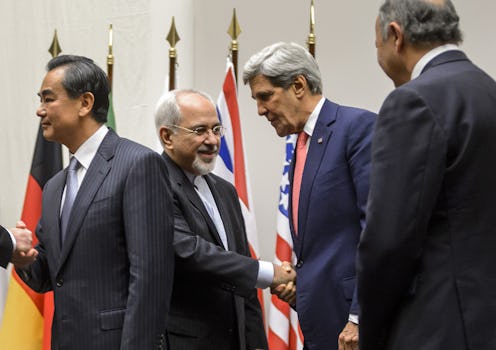News
What Does The U.S.-Iran Deal Even Mean?
After 36 years of tension and weeks of intense talks in Switzerland, on Thursday negotiators announced a framework for an agreement with Iran over its nuclear program, The Washington Post reported. If Iran meets the conditions of the still-to-be-signed and sealed deal for the next 15 years, many sanctions imposed by the U.S. and the European Union would be lifted. It's a confusing situation for people to fully understand, so here's a breakdown of what the United States & Iran nuclear deal means.
It's a complicated deal, but was praised as being far-reaching and thorough by international observers. If the deal is approved by June 30, Iran will curttail its ability to produce materials used in nuclear weapons and wind down operations at its nuclear facilities, according to The Post. And if Iran at any point broke the terms of the agreement, the way the framework is designed, it would still be a year away from being able to build a nuclear weapon. If it did violate the terms, the sanctions would go back into effect. In a statement from the Rose Garden at the White House, President Obama praised the framework, CNN reported, which was worked out with negotiators from Iran, the U.S., the U.K., China, France, Germany and Russia.
It is a good deal, a deal that meets our core objectives. This framework would cut off every pathway that Iran could take to develop a nuclear weapon.
So, what are the specifics of the deal? They're pretty involved, and they change over time. During the first 10 years of the deal, the restrictions are much tighter, but most will gradually expire after 15 years.
Changing Facilities' Purposes
To start, Iran will be required to convert several nuclear facilities. A nuclear reactor in Arak will be reconfigured so it's unable to produce plutonium, and an enrichment facility in Fordow will become a research facility, for instance, according to The Post.
Reducing Number Of Nuclear Machines, Facilities, & Chemicals
Iran will reduce the number of centrifuges it has, which are used to enrich uranium so it can be used in a nuclear bomb, and it will not build any new nuclear facilities under the terms of the agreement, for that initial 10-year period. The uranium Iran does have will be reduced by 98 percent, and, it will not be able to enrich that uranium beyond what is needed for a nuclear power plant, according to CNN.
Allowing Production Eventually
After the first 10 years, Iran would be allowed to increase its production of uranium and other nuclear materials, The New York Times reported. The deal will also allow more sweeping access for International Atomic Energy Agency inspectors, which remain in effect for the entire 15 years of the agreement as it's now written.
Penalizing If Deal Is Broken
Reports about this deal stressed that there are still a lot of details to be worked out, including how quickly economic sanctions against Iran would be lifted. President Obama warned that once the terms are finalized, the sanctions would snap back into place if Iran fails to meet the requirements, the BBC reported. "If Iran cheats, the world will know it."
But it seems clear that for the first time in a very long time, there is hope that more normal relations with Iran and the rest of the world might finally be possible.
Images: Getty Images (4)
